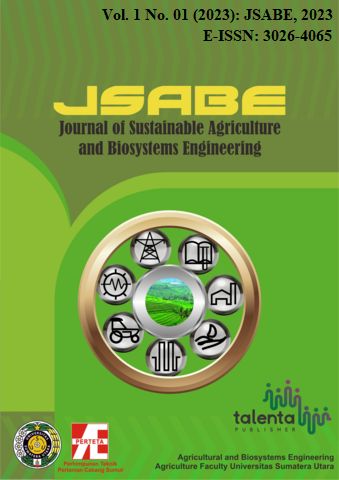Calibration of Proximate Content of Arabica Sidikalang Green Bean Coffee Using NIRS and PLS
Calibration of Proximate Content of Arabica Sidikalang Green Bean Coffee Using NIRS and PLS
DOI:
https://doi.org/10.32734/jsabe.v1i01.9640Abstract
Generally, coffee bean’s content measurement is conducted destructively, where it is known to be less effective. Measurement using the Near Infrared Spectroscopy (NIRS) method could be an alternative to a rapid determination of the chemical content non-destructively. The study aimed to obtain a partial least square (PLS) calibration model of water, lipid and carbohydrate content in Sidikalang Arabica green bean coffee. This method can predict the chemical content assisted with several data pretreatments, namely multiple scatter correction (MSC), standard normal variative (SNV), normalization, first derivative (dg1), second derivative (dg2), combination of dg 1 + MSC and combination of dg2 + MSC. Results showed that the best calibration model for water content was obtained using normalization with 6 PLS factor with r value of 0.574. moreover, the best calibration model in lipid content was obtained using MSC with 5 PLS factor with r value of 0.647, and the best calibration model for carbohydrate was using MSC with 6 PLS factors with r value of 0.563. The model obtained from this study is categorized into a moderate model and could be use in simulations with predictive values ​​with moderate accuracy.
Generally, coffee bean’s content measurement is conducted destructively, where it is known to be less effective. Measurement using the Near Infrared Spectroscopy (NIRS) method could be an alternative to a rapid determination of the chemical content non-destructively. The study aimed to obtain a partial least square (PLS) calibration model of water, lipid and carbohydrate content in Sidikalang Arabica green bean coffee. This method can predict the chemical content assisted with several data pretreatments, namely multiple scatter correction (MSC), standard normal variative (SNV), normalization, first derivative (dg1), second derivative (dg2), combination of dg 1 + MSC and combination of dg2 + MSC. Results showed that the best calibration model for water content was obtained using normalization with 6 PLS factor with r value of 0.574. moreover, the best calibration model in lipid content was obtained using MSC with 5 PLS factor with r value of 0.647, and the best calibration model for carbohydrate was using MSC with 6 PLS factors with r value of 0.563. The model obtained from this study is categorized into a moderate model and could be use in simulations with predictive values ​​with moderate accuracy.
Downloads
Downloads
Published
Issue
Section
License
Copyright (c) 2023 Journal of Sustainable Agriculture and Biosystems Engineering

This work is licensed under a Creative Commons Attribution-ShareAlike 4.0 International License.



